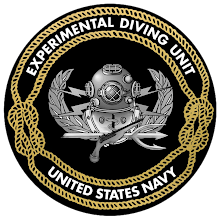The use of oxygen in recompression therapy in the Navy does not go back as far as many believe. In fact, it was not until the 1924 edition of the US Diving Manual that a standard recompression therapy was recommended at all; but these were all air tables. Treatment pressure was based on either the depth of the dive (or a multiple thereof) or the depth of relief, oxygen simply wasn't used back then. It wasn't that no one hadn't thought of using O2 however. The roots of using oxygen as therapy for diving illness can be traced back to Paul Bert's experiments way back in 1870. He first observed that when 100% oxygen on the surface was administered to animals after decompression, some of the signs would resolve. Surprisingly, Bert did not try hyperbaric oxygen, which was first proposed several years later. Initial results were actually disappointing, probably because the therapy was too brief.
In 1939, two US Navy medical officers (Yarbrough and Behnke) first published results of DCS treatment using compressed oxygen, but despite their success, the technique was not initially adopted. Instead for the next 20 years, the US Navy continued to recommend a variety of air tables despite long treatment duration and high failure rates. While these deep air tables provided a higher amount of oxygen, they also caused divers to take up amounts of inert gas in doing so. In the early 1960s, the US Navy instituted another series of investigations into low-pressure oxygen tables. Originally tests used 33 feet as a treatment depth; but due to a high recurrence rate, they were altered to use an initial recompression to 60 feet. This treatment depth not only dramatically improved treatment success, but did so in keeping the risk of oxygen toxicity at an acceptable level - the Navy had found "the sweet spot".
On August 22, 1967, Treatment Tables 5 and 6 were introduced into the U.S. Navy. These treatment tables marked the first time that 100 percent oxygen was used at relatively shallow treatment depths in comparison to the deeper air treatment tables (TT's 1-4). Two additional tables were also introduced (TT-5A and TT-6A) that began with an initial deep short excursion on air followed by treatment profiles identical to tables 5 and 6 (TT-5A was quickly abandoned). Because of the success of low-pressure oxygen treatment of decompression sickness, tables 1-4 are now rarely used. Continued experience with the O2 treatment tables revealed frequent reoccurrences of decompression sickness with the shorter procedures in Tables 5, which now sees limited use for treating diving related illness. TT's 7 and 8 were developed in the 80s to address a longer need for oxygen breathing at 60 feet or deep blow-up respectively; followed by TT-9 in the 90s mostly for non-diving disorders with great success.
Reading: Check out "Diving Medicine" by Alfred A. Bove and Jefferson Davis. This book is commonly referred to as The Bove ('Bo-veigh') and I guarantee that either your friendly neighborhood Master Diver, Diving Medical Officer or Diving Medical Technician has a copy.
H/Y


No comments:
Post a Comment